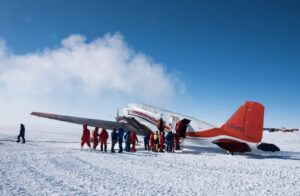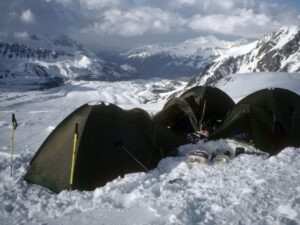After nearly eight months and 7,600km, Guillaume Moreau and Nicolas Roulx have completed their epic multi-discipline expedition from northern Ellesmere Island to Point Pelee National Park in southern Ontario, near the Canada–U.S. border.
Their almost north-to-south project may be the longest ever wilderness expedition in Canada since Knud Rasmussen’s 30,000km Fifth Thule Expedition of 1921-24. Moreau and Roulx’s route involved two ski sections totaling 1,450km, two canoe sections totaling 2,000km, and a final 4,150km run southeast by bicycle.

The team’s progress is marked by black pins and the red line shows their original route plan. The map stopped updating at Sault Ste. Marie a few days ago, but the team has now arrived at their endpoint in Point Pelee National Park. Photo: Expedition AKOR
Together with friend Jacob Racine, Roulx and Moreau opened the expedition on March 19 with an 800km slog from the Eureka weather station on Ellesmere Island to Resolute. They endured polar rash, knee injuries, and long periods of zero visibility while cranking out 20km days.
Almost North-South
Although they had originally billed the expedition as a full vertical traverse of Canada, the extra $30,000 cost to fly to Cape Aldrich on northern Ellesmere Island made them settle for an almost north-route route that was just about 680km short.
From Resolute, the trio had to further re-evaluate their route to Gjoa Haven. Barrow Strait, the channel between Cornwallis Island, on which Resolute sits, and Somerset Island, had broken up. It was now mainly open water. Rather than risk the crossing, they chartered a plane to fly them 80km over the gap to safe ice beside Somerset Island.

The start of their journey, in the deep cold of mid-March, was particularly demanding. Photo: Expedition AKOR
After hopping over the 80km, Moreau, Roulx, and Racine had another 600km to ski. The spring ice was much better than further north, offering superior glide and allowing for some 30km days.
In Gjoa Haven, Racine left the team as planned and Philippe Voghel-Robert and Etienne Desbois joined Moreau and Roulx for the 700km canoe journey inland to Baker Lake. Their ski journey from northern Ellesmere had been physically and mentally draining. Moreau and Roulx were excited to switch to their primary discipline, canoeing. But first, they needed to reach the thawing waterways.
The switch to canoeing
Originally, they had planned to paddle up the Back River into the heart of Canada. However, the cold spring and chilly start to summer meant that rivers and lakes had only just started to break up.
Skiing on the river as it broke up would be too dangerous. Instead, they headed further west, using a web of smaller rivers and lakes to progress. Transitioning the canoes from ice to water and back again, sometimes several times a day, was punishing both for the team and the canoes.

The switch to canoes didn’t necessarily mean less manhauling. Photo: Expedition AKOR
Finally, in mid-July, the lakes had melted and the final leg of their journey to Baker Lake could proceed more traditionally. But perhaps the canoe manhauling took a toll beyond the physical. Unexpectedly, Voghel-Robert left the expedition at Baker Lake. Catherine Chagnon, Moreau’s girlfriend, stepped in to fill the void, and the expedition continued south, originally towards Black Lake.
Wind, wind, wind
This section involved lots of upriver paddling, but it was the horrendous weather that derailed them. “There was lots of hauling but the rivers went OK,” Moreau explained, “but every time we were on a big lake, we were windbound. It wasn’t difficult to paddle, it was impossible.”
They were only able to paddle for 10 of their first 18 days after Baker Lake. For the other eight days, they battened down the hatches and hid from the weather. The awful conditions necessitated an emergency food pickup at a lodge on Kasba Lake and another major route change. To get back to Black Lake from Kasba Lake, they would have had to go north and west, adding many extra kilometers. Instead, they headed directly south on a “very shitty line.”
Despite the tricky canoe sections, in late September they hit their first road of the entire expedition and transitioned to bicycles. Isabella Donati-Simons and Beatrice Lafreniere joined them for the final run. They flew through the last 4,150km and arrived at Point Pelee National Park in southern Ontario on November 8.
“We went to soak our feet in Lake Erie, at the end of the sand tip that represents the southern end of Canada,” they said. In the end, it took them 234 days — seven-and-a-half months.

Moreau and Roulx experienced every season, setting off in early spring and ending in early winter. Photo: Expedition AKOR
The sheer scope of Moreau and Roulx’s journey is staggering. An epic undertaking from the frozen north through huge swathes of the Canadian wilderness to near the U.S. border, each stage of their journey would make for an impressive stand-alone expedition. Taken together, we have a strong contender for the most impressive expedition of 2021.

Lake Erie: End of the long trail at last. Photo: AKOR expedition






